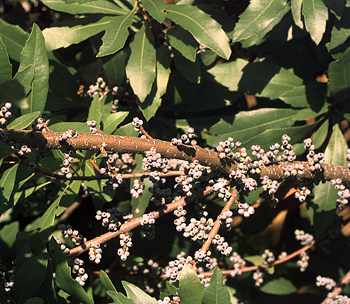

Bayberry is a deciduous shrub usually found in Asia, Africa, throughout
the eastern and southern USA except the parts of Australasia (Australia,
New Zealand and New Guinea).
The uses of this shrub as a traditional medicine have been reported since
thousands years back.
Myrica cerifera is the only specie which is useful and found in swamps
and marshes in the sand-belt near the Atlantic coast and on the shores of
Lake Erie.
The height of bayberry shrub is nearly 3 to 8 feet and leaves are
lustrous, lanceolate, and resinous but dotted from both sides, fragrant
when rubbed.
The flowers of bayberry plant are unisexual but without calyx or corolla
and the fruit consist of red glabrous berries having numerous black grains
crusted with greenish white wax.
The bark of this plant is covered with a thin layer and the cork beneath
is smooth and red-brown. It bears aromatic odour and taste very acidic.
Bayberry is widely cultivated in eastern and southern US. Autumn and
spring is the time when bayberry's bark is collected.
Root bark
The main constituents of bayberry are triterpines, flavonoids, phenols, tannins, resins and gums.